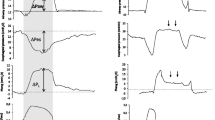Abstract
The effectiveness of Continuous positive airway pressure (CPAP) administration in improving blood oxygenation and the importance of the circuit capacity, by checking two different volumes of balloon reservoirs (a 3 1 versus 23 1 balloon), in reducing the work of breathing is presented. Twenty-five postoperative patients, after major gastrointestinal interventions were included in this study. Each patient being studied under three different conditions: Phase I: spontaneous breathing, Phase II: CPAP — 11 cmH2O, 3 1 balloon reservoir; Phase III: CPAP — 11 cmH2O, 23 1 balloon reservoir. All patients were intubated and were breathing room air. The results obtained clearly show a significant improvement in blood oxygenation due to CPAP, pM0.001. In addition, the work of breathing was considerably reduced utilizing a large capacity system with significant lower flow rates, pM0.001 and p(0.0001 respectively. Furthermore, rebreathing was prevented by maintaining continuous bubbling in the exit chamber and proved by having no change in PaCO2.
Similar content being viewed by others
References
Anderes C et al. (1979) Post-operative spontaneous breathing with CPAP to normalize late postoperative oxygenation. Intensive Care Med 5:15
Anderson JB, Olesen KP, Eikard B et al (1980) Periodic continuous positive airway pressure, CPAP, by mask in the treatment of atelectasis: A sequential analysis. Eur J Respir Dis 61:20
Barach AL, Martin J, Eckman M (1938) Positive pressure respiration and its application to the treatment of acute pulmonary edema. Ann Int Med 12:754
Braschi A, Iotti G, Locatelli A, et al (1983) Convalida funzionale del circuito di CPAP a flusso libero con reservoir ad alta compliance: valutazione del problema del rebreathing. In: Giron GP, Vincenti E (eds) Atti del XXXV Congresso Nazionale SIAARTI-CLEUP-Padova Pag.: 513
Civetta JM, Brons R, Gabel JG (1972) A simple and effective method of employing spontaneous positive-pressure ventilation. J Thorac Cardiovasc 63:312
Covelli HD, Weled BJ, Beekman JF (1982) Efficacy of continuous positive airway pressure administration by face mask. Chest 81:147
Gherini S, Peters RM, Virgilio RW (1979) Mechanical work on the lungs and work of breathing with positive end-expiratory pressure and continuous positive airway pressure. Chest 76:251
Gibney RTN, Wilson RS, Pontoppidan H (1981) Comparison of work of breathing on high gas flow and demand value continuous positive airway pressure systems. Chest 80:382 (Abstract)
Glasser KL, Civetta JM, Flor RJ (1975) The use of spontaneous ventilation with constant positive airway pressure in the treatment of salt water near-drowning. Chest 67:355
Greenbaum DM, Millen JE, Eross B, Snyder JV, Grevnik A, Safar P (1976) Continuous positive airway pressure without tracheal intubation in spontaneously breathing patients. Chest 69:615
Pelizzola A, Mascheroni D, Marcolin R et al. (1981) Reservoir ad alta compliance per l'ottimizzazione di un circuito di CPAP. Anest Rianim 22:279
Pingleton SK (1982) Complications associated with the adult respiratory distress syndrome. Clin Chest Med 3:143
Richard M Peters (1974) Work of breathing and abnormal mechanics. Surg Clin North Am 54:955
Roeseler J, Tremouroux J, Soete M, Reynaert M, Francis Ch (1982) Effets de trois méthodes d'assistance respiratoire sur la PaO2 et la PaCO2 chez l'opéré digestif (pression positive continue; pression positive intermittente, kinésithérapie respiratoire clasique). Poumon Coeur 38:135
Roussos C, Macklem PT (1983) The respíratory muscles. Int Crit Care Digest 2:3
Shah DM, Newell JC, Dutton RE, Powers SR et al. (1977) Continuous positive airway pressure versus end-expiratory pressure in respiratory distress syndrome. J Thorac Cardiovasc Surg 74:557
Simonneau G, Lemaire F, Harf A et al. (1982) A comparative study of the cardiorespiratory effects of continuous positive airway pressure breathing and continuous positive pressure ventilation in acute respiratory failure. Intensive Care Med 8:61
Smith RA, Kirby RR, Gooding JM, Civetta JM (1980) Continuous positive airway pressure (CPAP) by face mask. Crit Care Med 8:483
Taylor GJ, Brenner W, Summer WR (1976) Severe viral pneumonia in young adults: therapy with continuous positive airway pressure. Chest 69:722
Thomas L, Robert D, Malguarth M, Gerard M, Kirkurian G, Bertoye A (1979) Travail respiratoire lors de la ventilation spontanée en pression positive continue: importance de la capacitance du circuit. Nouv Presse Med 8:45
Author information
Authors and Affiliations
Rights and permissions
About this article
Cite this article
Roeseler, J., Bshouty, Z.H. & Reynaert, M.S. The importance of the circuit capacity in the administration of CPAP. Intensive Care Med 10, 305–308 (1984). https://doi.org/10.1007/BF00254321
Accepted:
Issue Date:
DOI: https://doi.org/10.1007/BF00254321




